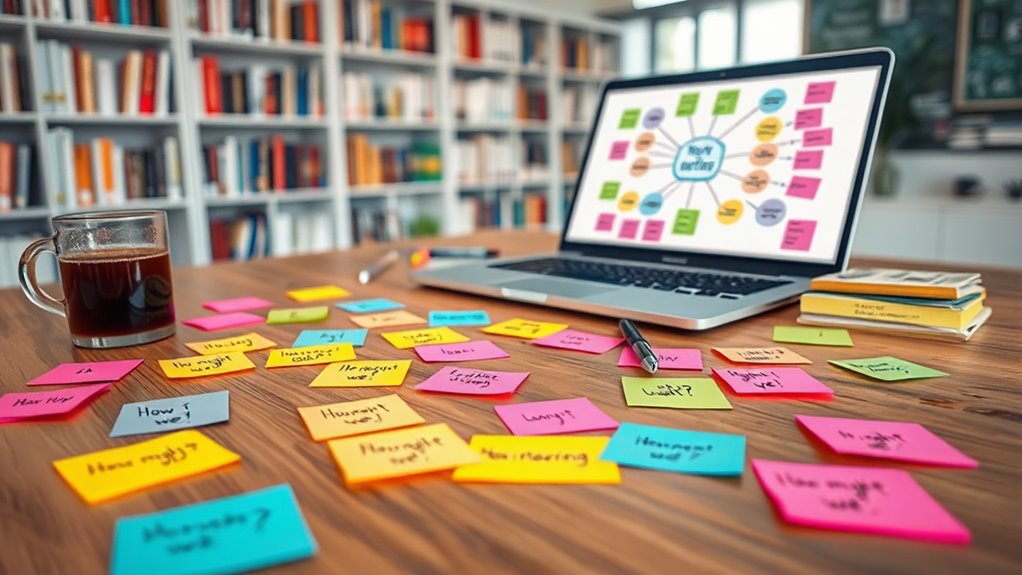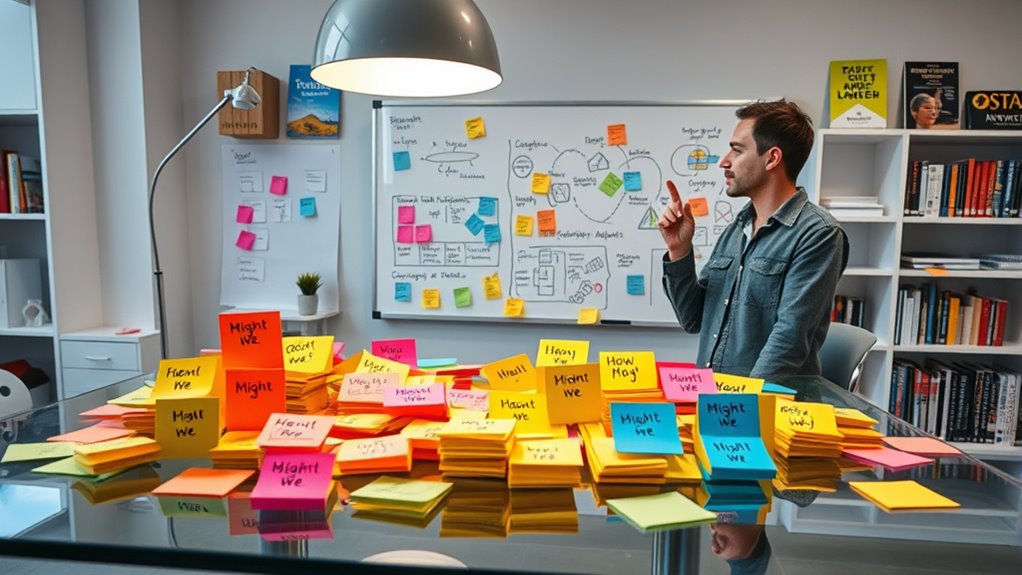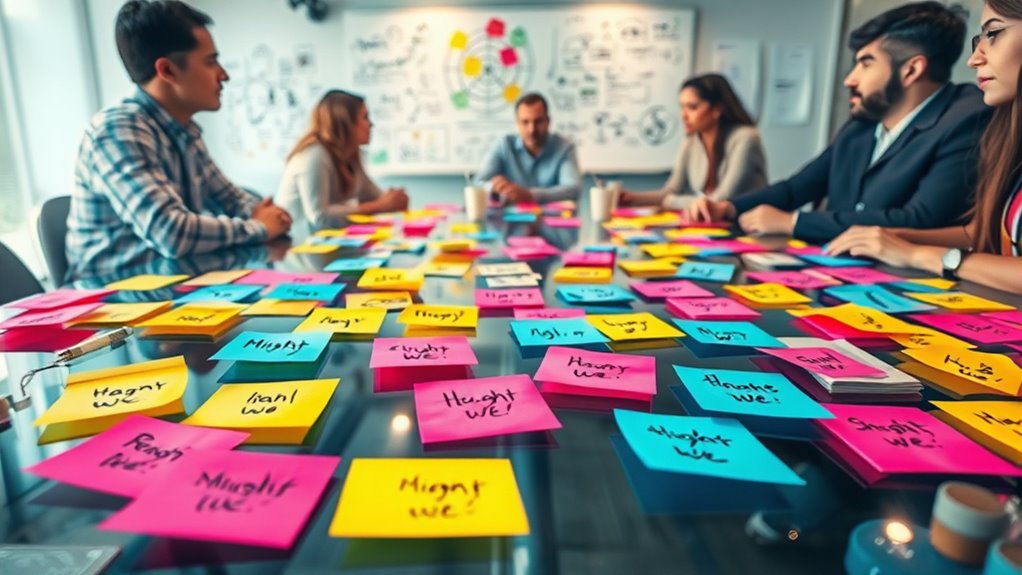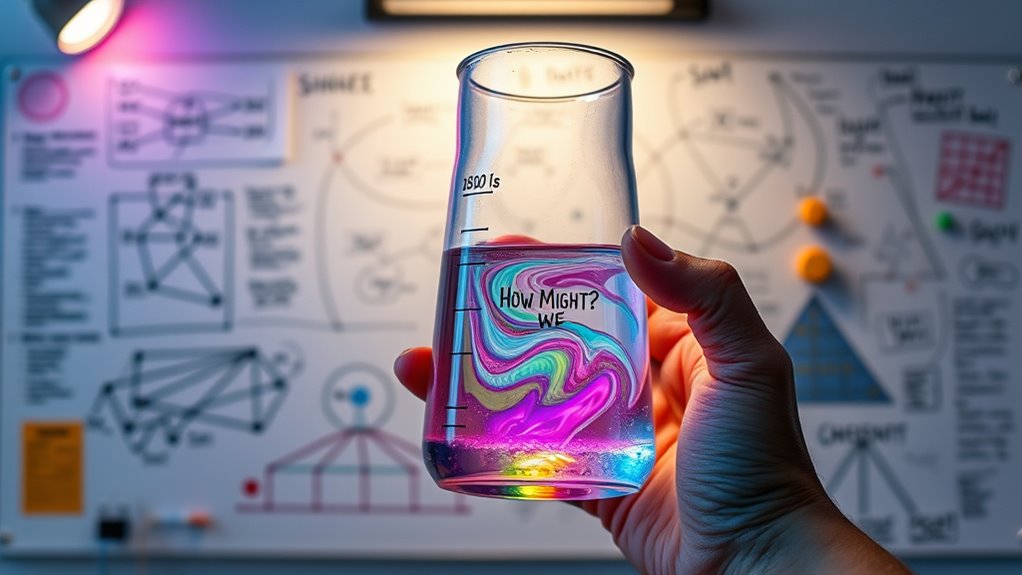“How Might We” questions activate your brain’s creative and neural pathways by encouraging curiosity, positive framing, and open-ended thinking. They promote cognitive flexibility, helping you explore unconventional solutions and foster collaboration. This approach strengthens neural connections related to pattern recognition and idea generation, making innovation easier. By shifting your mindset to possibilities instead of obstacles, you unleash new perspectives. Keep exploring, and you’ll discover how this powerful questioning technique sparks breakthrough ideas and teamwork.
Key Takeaways
- “How Might We” questions activate neural pathways related to curiosity, pattern recognition, and creative thinking, fostering innovative ideas.
- Framing challenges as positive, open-ended questions enhances cognitive flexibility and promotes mental agility essential for innovation.
- These questions stimulate the prefrontal cortex, encouraging reasoning, exploration, and the generation of unconventional solutions.
- They create a collaborative environment, leveraging diverse perspectives to enhance idea generation and problem-solving.
- The strategic framing of problems as “How Might We” questions shifts mindsets toward possibility thinking, resilience, and adaptive innovation.
The Origins of “How Might We” Questions in Design Thinking

The origins of “How Might We” questions trace back to the principles of design thinking, a methodology that emphasizes human-centered problem solving. Their history evolution reflects a shift toward collaborative and creative approaches in innovation. Design thinking emerged in the 1960s, but it was in the 2000s that “How Might We” questions gained prominence as a core tool. Originally, these questions evolved from brainstorming techniques designed to foster open-ended exploration. Over time, they transformed into strategic prompts that encourage teams to reframe challenges positively. Their history evolution highlights a focus on empathy, experimentation, and iteration—key elements that make “How Might We” questions powerful for sparking innovative ideas. Today, they serve as foundational tools in various disciplines, guiding teams toward creative solutions. Additionally, understanding breast cancer symptoms can be crucial in early detection and effective treatment, exemplifying how targeted questions can lead to impactful insights.
Cognitive Foundations of Open-Ended Inquiry

When you ask open-ended questions like “How might we,” you stimulate your creative thinking and open your mind to new possibilities. This approach fosters cognitive flexibility, helping you adapt and explore different perspectives. As a result, your problem-solving skills become sharper and more innovative. Incorporating mindful decluttering strategies can also enhance this process by creating a clearer environment that promotes focused thinking.
Encourages Creative Thinking
Have you ever wondered how open-ended questions like “How might we” spark your creative thinking? These questions promote a mindset shift, encouraging you to see problems as opportunities rather than obstacles. This shift unleashes your ability to generate new ideas without self-imposed limits. When you approach challenges with a “How might we” perspective, you open the door to diverse possibilities, fueling idea generation. It’s about stepping outside your usual thought patterns and embracing curiosity. This open-ended approach helps you explore unconventional solutions and connect ideas in novel ways. By fostering a creative mindset, these questions activate your imagination and problem-solving skills, making innovation more natural and accessible. Additionally, understanding relationship dynamics can help you navigate social interactions more effectively, further enhancing your creative problem-solving. Ultimately, they inspire you to think beyond boundaries and discover fresh, impactful solutions.
Promotes Cognitive Flexibility
Ever wonder how open-ended questions like “How might we” enhance your ability to think flexibly? These questions tap into neuroplasticity, the brain’s capacity to rewire itself, boosting your mental agility. By encouraging you to explore multiple perspectives and consider various solutions, they push your brain to adapt and shift approaches. This mental flexibility is essential for innovation, as it helps you break free from rigid thinking patterns and embrace new ideas. When you engage with open-ended queries, your brain creates new neural connections, strengthening your ability to pivot and respond creatively to challenges. Over time, this cultivates a mindset open to change, making you more adaptable in both problem-solving and everyday thinking. Additionally, understanding AI vulnerabilities and how to address them can help you develop more resilient and innovative solutions.
Stimulates Problem-Solving Skills
How do open-ended questions like “How might we” sharpen your problem-solving skills? They activate your brain plasticity, encouraging you to form new neural connections as you explore different solutions. This mental agility allows you to approach challenges from multiple angles, fostering flexible thinking. By constantly adapting your strategies, you strengthen your ability to analyze complex problems and generate innovative ideas. When you engage with open-ended questions, you’re not just finding answers—you’re training your brain to think critically and creatively under pressure. Over time, this enhances your problem-solving skills, making it easier to navigate unfamiliar situations. Additionally, engaging with open-ended questions can improve your cognitive flexibility, enabling you to switch between different ideas and perspectives more effectively. Ultimately, “How might we” questions challenge your mind to stay adaptable, sharpening your cognitive toolkit for any challenge you face.
The Role of Curiosity and Exploration in Creativity

Curiosity acts as the spark that ignites creative exploration, encouraging you to question assumptions and seek out new possibilities. When you embrace an exploratory mindset, you open yourself to curiosity-driven innovation, where every question becomes a chance to discover something novel. This desire to explore fuels your willingness to venture beyond familiar ideas, pushing boundaries and uncovering unexpected solutions. Curiosity motivates you to dig deeper, challenge the status quo, and connect seemingly unrelated concepts. As you explore, your creativity expands, enabling you to see opportunities others might overlook. Cultivating curiosity isn’t just about gathering information; it’s about actively engaging with the world around you to spark fresh ideas and innovative breakthroughs. Additionally, fostering a mindset of Free Floating allows ideas to flow more freely, encouraging continuous experimentation and discovery.
Brain Activation and Neural Pathways Engaged by Questioning

As you ask questions, your brain activates specific neural pathways that facilitate problem-solving and creative thinking. This neural activation involves engaging areas like the prefrontal cortex, which manages executive functions such as reasoning and planning. When questioning, pathways associated with curiosity and exploration are stimulated, encouraging flexible thinking and pattern recognition. These cognitive pathways enable you to connect disparate ideas, generate new solutions, and approach problems from fresh angles. Questioning also triggers the hippocampus, supporting memory retrieval and associative thinking. Additionally, engaging these neural networks can promote market growth in AI technology by fostering innovative problem-solving approaches. By activating these networks, your brain enhances its ability to process complex information, fostering innovation. The more you question, the more these neural pathways strengthen, making you better equipped to tackle future challenges with creativity and insight.
The Impact of Framing on Problem-Solving Strategies

The way you frame a problem can considerably influence your mindset and approach to solving it. Using specific techniques, you can shape your perspective to foster creativity and open new possibilities. Recognizing framing’s impact helps you develop more effective problem-solving strategies. For instance, understanding different compatibility factors can lead to more tailored and innovative solutions.
Mindset Shaping Techniques
How you frame a problem can considerably influence your problem-solving approach and mindset. A mindset shift, prompted by your framing choices, can turn a challenge into an opportunity for innovation. By intentionally shaping your perspective, you create an environment where solutions emerge more easily. This framing acts as an innovation catalyst, encouraging you to explore new angles and possibilities. Techniques like reframing questions or focusing on positive outcomes help you break free from fixed thinking patterns. When you adopt a growth-oriented mindset, you’re more open to experimentation and collaboration. Understanding the science behind sound healing and how specific frequencies influence your brainwaves can further enhance your problem-solving toolkit. Ultimately, your mindset shaping techniques set the stage for creative problem-solving, empowering you to see opportunities where others see obstacles. This deliberate approach fuels progress and drives innovative solutions.
Creativity Through Framing
Framing a problem shapes the way you approach solutions and sparks creative thinking. Conceptual framing sets the lens through which you view challenges, guiding your focus and influencing the ideas you generate. It helps you identify relevant angles and possibilities you might overlook otherwise. Cognitive scaffolding provides support, breaking down complex issues into manageable parts that foster clarity and insight. By adjusting your framing, you reshape your perspective, encouraging innovative approaches. Effective framing encourages you to think beyond obvious solutions, opening pathways for novel ideas. When you consciously manipulate how a problem is presented, you create an environment where creativity thrives. This strategic framing empowers you to explore diverse solutions and enhances your problem-solving effectiveness. Recognizing different problem-solving techniques can further expand your creative toolkit and improve your outcomes.
How “How Might We” Fosters Collaborative Thinking

Have you ever noticed how “How Might We” questions encourage team members to build on each other’s ideas instead of competing? They create a space for collaborative brainstorming, where everyone feels valued and heard. This approach shifts the focus from individual success to collective problem-solving, fostering team synergy. When you use “How Might We,” it invites diverse perspectives, making it easier to generate innovative solutions together. By framing challenges positively, it reduces defensiveness and promotes open dialogue. As a result, team members are more willing to share their insights and explore new possibilities. This shared mindset strengthens relationships and enhances cooperation, making the group more effective at addressing complex issues. Overall, “How Might We” questions cultivate a collaborative environment essential for innovation.
Psychological Benefits of Embracing Possibility Thinking

Embracing possibility thinking through “How Might We” questions can substantially boost your psychological well-being. When you adopt this mindset, you encourage positive mindset shifts that move you away from limitations and toward growth. This approach nurtures optimism, resilience, and curiosity, which are essential for mental health. By engaging in idea incubation, you give yourself space to explore multiple solutions without immediate judgment, reducing stress and fear of failure. This process fosters a sense of agency and confidence, empowering you to see challenges as opportunities. As you practice these techniques, you develop a more adaptive outlook, making it easier to navigate setbacks and embrace change. Overall, possibility thinking enhances your mental resilience and sparks a more hopeful, proactive attitude toward problem-solving and innovation.
Case Studies: When These Questions Led to Breakthroughs

Many innovative breakthroughs have originated from the power of “How Might We” questions, transforming challenges into opportunities for creative solutions. For example, Airbnb’s founders asked, “How might we create a trusted community marketplace for lodging?” This question sparked transformative insights that revolutionized the hospitality industry. Similarly, the development of the iPhone involved asking, “How might we simplify mobile technology for everyday users?” This inquiry led to innovative breakthroughs in design and functionality. These case studies demonstrate that framing problems with “How Might We” questions open up fresh perspectives and drive meaningful progress. By shifting focus from obstacles to possibilities, you can harness this approach to generate breakthroughs that reshape industries and inspire innovation.
Practical Tips for Applying “How Might We” in Your Work

Wondering how to effectively incorporate “How Might We” questions into your work? Start by embracing mindset shifts that encourage curiosity and openness. Frame problems as opportunities for innovation sparks rather than obstacles. Use “How Might We” to foster collaborative thinking, inviting diverse perspectives that spark creative solutions. Keep your questions specific enough to guide focus but broad enough to inspire new ideas. Regularly practice reframing challenges with these questions to build an innovative mindset. Encourage your team to view setbacks as learning moments and to approach problems with a growth-oriented attitude. By integrating these questions into daily routines, you cultivate an environment where innovation naturally flourishes, *accessing* fresh insights and breakthrough solutions.
Frequently Asked Questions
How Do “How Might We” Questions Influence Long-Term Innovation Strategies?
You see, “How Might We” questions shape your long-term innovation strategies by fostering stakeholder engagement and encouraging strategic alignment. They prompt you to explore diverse perspectives, making your team more adaptable and forward-thinking. As you focus on these questions, you build a culture of continuous improvement, ensuring your innovations stay aligned with your goals and stakeholder needs. This approach keeps your strategy flexible and better positioned for sustainable growth.
Can “How Might We” Questions Be Adapted for Non-Creative Fields?
You can adapt “how might we” questions for non-creative fields by focusing on cross-disciplinary integration and problem reframing. These questions encourage you to view challenges from different angles, fostering innovative solutions even outside traditional creative areas. By framing issues as opportunities for exploration, you help break down silos, promote collaboration, and inspire fresh perspectives, making them a powerful tool for tackling complex problems across diverse industries and disciplines.
What Are Common Pitfalls When Formulating “How Might We” Questions?
When formulating “how might we” questions, you should watch out for bias awareness and clarity issues. Avoid framing questions that lead to biased or limited solutions, and make certain they’re clear enough for everyone to understand. Vague questions can hinder creativity, so be specific. By focusing on neutrality and clarity, you help foster innovative ideas instead of restricting possibilities or causing confusion.
How Does Individual Diversity Affect the Effectiveness of “How Might We” Inquiries?
Imagine a diverse team brainstorming, each person’s unique perspective like different lenses sharpening the view. Your individual diversity, regarding cognitive diversity, boosts the effectiveness of “How Might We” inquiries by introducing varied insights that challenge bias and spark creativity. By embracing these differences, you mitigate bias, leading to more innovative solutions. Your team’s diversity becomes a powerful tool, transforming questions into opportunities for breakthrough thinking.
Are There Cultural Differences in the Perception and Use of “How Might We” Questions?
You might notice that cultural perceptions influence how “How Might We” questions are received and used. In some cultures, communication barriers lead to hesitation or formal responses, while others encourage open dialogue and creative thinking. Understanding these differences helps you tailor your approach, ensuring your questions foster collaboration and innovation across diverse teams. Recognizing cultural perceptions allows you to navigate communication barriers effectively, opening more meaningful and inclusive ideas.
Conclusion
By embracing “How might we” questions, you open doors to curiosity, ignite creativity, and foster collaboration. You challenge assumptions, expand possibilities, and spark innovation. You turn problems into opportunities, doubts into discoveries, and ideas into solutions. When you ask thoughtfully, you inspire progress; when you explore openly, you cultivate breakthroughs. Keep asking, keep exploring, and keep transforming challenges into chances—because that’s how innovation begins with a simple, powerful “How might we.”




